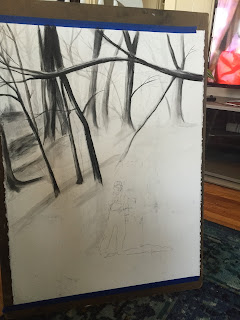Silk Suite of Dad
I had the privilege of critiquing
with both Beverly Semmes and Jane Gilmor this semester. Semmes was very
reserved and did not say much, but one thing she did say was that she wished I
could merge the looseness of the monotypes with my embroidery. Similarly,
Gilmor during our critique expressed that she was unimpressed with my
embroideries and more interested in Sewing
Suite. Gilmor, like Semmes, said she wished there was some way to merge the
two medias. I appreciated the feedback in both critiques; however, combining
fabric with my monotype prints was something I had been pondering all semester,
so for this final project I wanted to take advantage of my resources and try
the monotypes on both a larger scale and fabric.
I developed an interest in the
transparency of monoprints when I made my installation, Sundowning. I make my monotype prints in black ink on Plexiglas, so
it seemed like a natural step to project monoprints on my windshield in order
to see both sides. For this project I had a vision of printing on sheer fabric
in order to stack them up on top of each other with a backlight; the images
would be lined up so that the subtle movement of the figure would be visible in
all four prints. I had a vision of displaying them in a way that they could
slide together and stack up, or slide apart—similar to room dividers and pocket
doors.
I took reference photos of my dad
while I was talking to him one evening and chose China silk to print on because
it was sheer and would absorb the ink. I was pleased with the prints, as it was
the first time I had printed on fabric or did a monotype that large. After
moving them around and flipping them over I discovered that viewing the back of
the prints was almost as important as viewing the front. Because the prints
were reversible I wanted to display them in a way that allowed viewers to see both
sides. I constructed an armature that came out four feet from the wall to hold
the slats the silk prints are mounted to. This displayed allows viewers to
interact with the prints by moving them, as well as see both sides of the silk.
My classmates responded positively
to both the display and the prints; backlighting the prints became less
important to me as I watched my classmates interact with the work and I was
glad I chose not to do it. I am very exited about Silk Suite because of both the size and the material. I discovered
that the aesthetics of my monotype prints do not change much when printed
larger. Additionally, I am excited with all the possibilities of printing on
fabric. This piece has opened up doors in my art and I am excited to continue
exploring the possibilities of monoprinting on fabric.
















